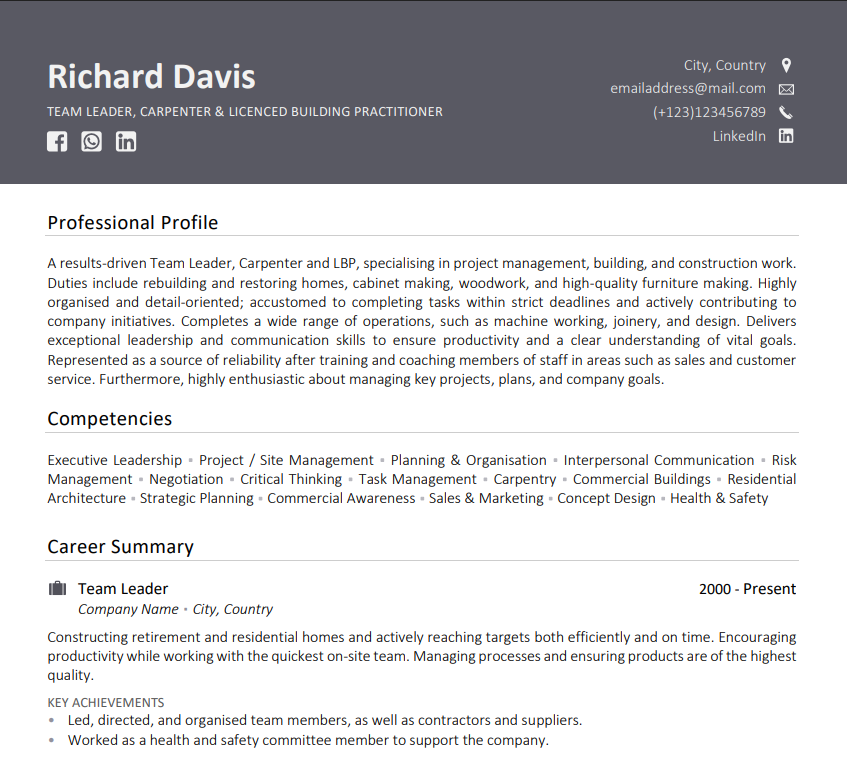Exploring the Different Types of CV: Which One Suits You Best?
Getting your CV right is one of the most important parts of the application process - it’s your first chance to make a strong impression. But did you know there’s more than one type of CV?
After all, CV writing isn’t just about listing your jobs. It’s about telling your story in a way that makes employers want to know more. And choosing the right CV type is the first step.
So if you’re ready to boost your chances and feel confident hitting “send” on your next job application, let’s explore the different CV types and find the one that shows you off at your best.
What Are the Different Types of CVs?
When it comes to CVs, there’s no “one-size-fits-all” – and that’s a good thing! Over the years, I’ve seen just how powerful it can be when someone switches to a CV style that actually fits their story.
In the UK job market, we generally work with three main types of CV:
- Chronological CV – This is the classic format most people are familiar with. It focuses on your work history, listing your roles in reverse order.
- Skills-Based (Functional) CV – This one highlights your transferable skills rather than the timeline of your experience.
- Combination (Hybrid) CV – As the name suggests, this style blends both approaches.
Which one suits you best? Well, that depends on you. Your background, your goals, your industry. A recent school leaver or graduate needs something very different to someone with 15 years in finance. We'll go into more detail on this throughout the blog.
If you’re serious about making your CV shine, grab a free CV review for expert advice from our team. We’ll take a proper look and let you know if your current layout is doing you justice - or if a simple switch could make all the difference.

The Chronological CV: Best for Career Progression
A chronological CV lays out your work experience in reverse order, starting with your most recent role and working backwards. It’s all about showing your career journey – where you’ve been, what you’ve done, and how you’ve moved forward.
If your career has been fairly smooth sailing with steady roles in the same field or if you have very relevant skills and experience, this format is your go-to. Employers love it because it’s easy to follow and gives a strong sense of progression.
Key Features
- A clear structure focusing on job titles, employers, and dates
- Descriptions under each role showing responsibilities and key achievements
- Often includes a brief profile at the top and a section for key skills
Pros
- Ideal for showcasing career growth and consistency
- Easy for hiring managers to scan and understand your background
- Highlights recent and relevant experience front and centre
Cons
- Not great if you’ve had time out of work, made lots of changes, or you’re moving into a new industry
- Can draw attention to employment gaps or a lack of recent experience in the field you’re targeting

The Skills-Based CV: Highlighting Your Abilities
The skills-based CV (also called a functional CV) is all about what you can do, not just where you’ve done it. Rather than listing your job history from top to bottom, this format puts your key skills and strengths front and centre.
It’s a brilliant choice if you’re changing careers, stepping back into work after a break, or your previous roles don’t neatly line up with where you’re heading next. Because it leads with skills rather than dates, employment gaps aren’t as noticeable, though it’s still worth being ready to explain them honestly if asked.
Key Features
- Organised by skill area (think: Leadership, Communication, Technical Skills)
- Each skill is backed up with specific examples
- A short employment history usually appears at the end
Pros
- Helps shift the focus away from job titles and onto strengths
- Excellent for drawing attention to transferable skills
- Gives you more control over the narrative
Cons
- Some recruiters aren’t fans – they prefer to see where and when you did things
- Can come across as vague if not backed up with solid evidence
- Needs to be carefully written to avoid sounding generic
The Combination CV: A Balanced Approach
The combination CV (or hybrid CV) is exactly what it sounds like, with the best bits of both the chronological and skills-based formats. You get to highlight your most relevant skills and include a clear work history, so it ticks a lot of boxes in one go.
This format is great for professionals with a good range of experience and a particular competency they want to shout about, especially if they’re looking to move sideways or slightly shift direction.
Key Features
- Starts with a summary of key skills or a strong personal profile
- Includes themed sections showcasing achievements and strengths
- Followed by a concise, reverse-chronological work history
Pros
- Offers flexibility to tailor your CV to the job at hand
- Lets you lead with impact and still show solid experience
- Great for people who don’t fit neatly into a single box
Cons
- Can get long or feel muddled if not carefully structured
- Takes a bit more time to get right, but worth it!
How to Choose the Right CV Type for You
So, you’ve met the main players – chronological, skills-based, and combination. But how do you actually choose the right one?
Practical Tips for Decision-Making
- Consider your career goals. If you're changing careers, a skills-based CV helps you shift the spotlight from your job titles to the abilities you're bringing with you. If your goal is to climb the ladder in your current industry, and you’ve got a solid work history to show for it, the chronological CV will likely do the trick.
- Look at the job description. What are they focusing on? If it’s full of skill-based language, consider leaning in that direction. If they want solid experience in a specific role, a chronological format might work better.
- Ask yourself what you want your CV to emphasise. Is it your steady experience? Your standout skills? Your adaptability? The answer will help point you towards the right format.
- Be honest about your work history. Gaps, career changes, or unrelated roles aren’t deal-breakers, but the right CV format can help frame them in a much more positive light.
- Test it. Seriously. Create two or three versions and see which one feels better. Sometimes the difference is obvious once you see your experience laid out.
Common Mistakes to Avoid When Writing Your CV
Look, nobody sets out to write a bad CV. But after reviewing thousands over the years, I can tell you there are a few common slip-ups that crop up time and time again - and the good news is, they’re all easily fixable once you know what to look for.
Cramming In Too Much Information
It’s completely natural to want to share your full story. You’ve worked hard, after all. But a focused CV that highlights your most relevant experience will always make a stronger impression than one packed with every role you've ever had.
A skills-based CV can help you cut through the noise by focusing on what you can do, rather than detailing every role you’ve had. A combination CV can also help with focus, especially if you’re juggling both relevant skills and work history - just keep an eye on repetition, as it’s easy to drift into waffle territory!
Formatting Chaos
A clear and well-organised layout helps guide the reader through your experience. If your CV is cluttered, inconsistent, or hard to scan, important details can get lost. Aim for simplicity and structure that allows your strengths to shine through.
Missing the Right Keywords
When employers or Applicant Tracking Systems scan your CV, they’re looking for language that matches the job description. Using relevant keywords helps show you understand what the role needs and that you’re a good match.
A combination CV can really shine in this area because it blends both skills and experience, giving you more flexibility to weave in keywords naturally.

Wrapping It Up
Whichever path you're on, the key is choosing a format that reflects you. Your CV should feel like a clear, confident introduction, not just a list of jobs. And the great news is, once you've got the right structure in place, everything else starts to fall into place.
The Next Level: Free CV Review
Want to make sure your CV is doing you justice?
Whether you're aiming for a career leap, a fresh start, or simply a role that lights you up again, we’ll give your CV a proper once-over and let you know how to make it stronger, sharper, and far more interview-worthy.
Let’s turn your experience into something that gets you noticed, so you can start applying to new jobs with confidence!

Frequently Asked Questions
I’ve answered a few of the most common questions on the types of CVs below.
What Type of CV Is Used in the UK?
The most commonly used CV format in the UK is the chronological CV, which lists your work experience in reverse order. But skills-based and combination formats are also widely accepted. It all depends on your background and goals.
Can I Use a Skills-Based CV if I Have No Work Experience?
Yes, a skills-based CV is ideal if you’ve got limited or no formal work experience. It lets you highlight transferable skills from education, volunteering, or other activities instead of focusing on job history.
What Are the Five Main Parts of a CV?
A solid CV typically includes: a personal profile, key skills, work experience, education, and additional sections like achievements or certifications.
Are There Any Other Types of CV?
Beyond the more commonly used CV formats, there are a couple of other types that come into play depending on your career path.
An academic CV is typically used for roles in research or higher education. It’s more detailed than a standard CV and focuses heavily on things like publications, teaching experience, research projects, and qualifications.
On the flip side, a video CV offers a more creative way to introduce yourself. It’s not about reading your CV out loud, but about showing off your communication skills or creative flair in a short video. That said, it’s best used as a complement - not a replacement - so always send it alongside a well-written CV.

